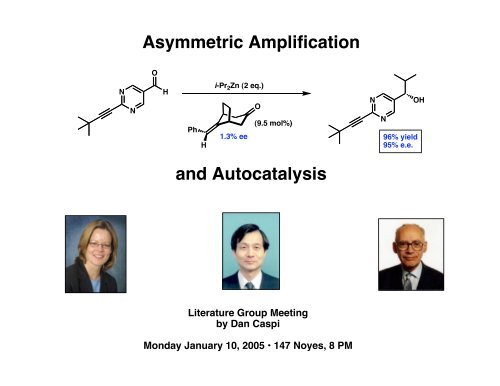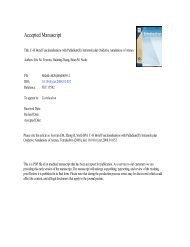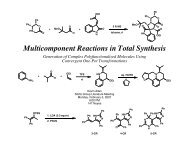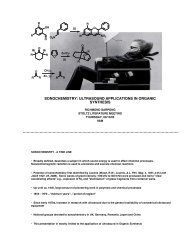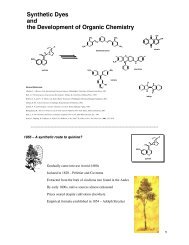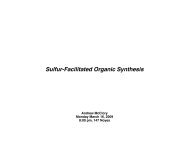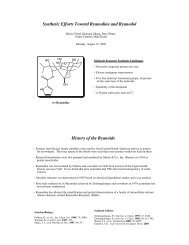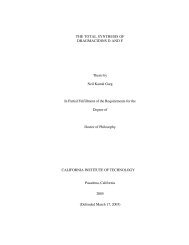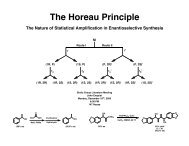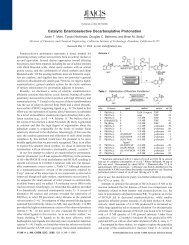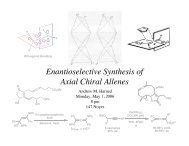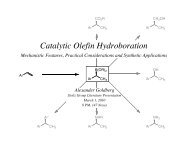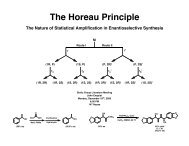Asymmetric Amplification and Autocatalysis - The Stoltz Group
Asymmetric Amplification and Autocatalysis - The Stoltz Group
Asymmetric Amplification and Autocatalysis - The Stoltz Group
Create successful ePaper yourself
Turn your PDF publications into a flip-book with our unique Google optimized e-Paper software.
<strong>Asymmetric</strong> <strong>Amplification</strong>ONNHPhHi-Pr 2 Zn (2 eq.)O(9.5 mol%)1.3% eeNN96% yield95% e.e.OH<strong>and</strong> <strong>Autocatalysis</strong>Literature <strong>Group</strong> Meetingby Dan CaspiMonday January 10, 2005 • 147 Noyes, 8 PM
Outline of TopicsI. Introductiona. Definitionsb. Biological ImplicationsII. <strong>Asymmetric</strong> <strong>Amplification</strong>a. Non-Linear Effectsb. Examplesc. Kinetic ModelsIII. <strong>Autocatalysis</strong>a. Explanationb. Soai Reactionc. Kinetic Models <strong>and</strong> MechanismIV. ConclusionAdditional Reviews:H. Kagan. Angew. Chem. Int. Ed. 1998, 37, 2922-2959.K. Soai. Acc. Chem. Res. 2000, 33, 382-390.H. Kagan. Synlett 2001, SI, 888-899.M. Todd. Chem. Soc. Rev. 2002, 31, 211-222.K. Mikami. Chem. Rev. 2003, 103, 3369-3400.K. Soai. Bull. Chem. Soc. Jpn. 2004, 77, 1063-1073.
A Brief Interlude About the Origins of LifeEach of life's crucial biomolecules - amino acids, sugars, <strong>and</strong> biopolymersexist in essentially complete enantiomeric homogeneityHOHOOHOHOOHOHNH 2L-ValineHOD-GlucoseHomochirality is a precondition for life, so...• How did life choose its h<strong>and</strong>edness?• How was high optical activity achieved from a racemic or prochiral prebioticenvironment?"A laboratory demonstrationmay not be impossible."F. C. FrankBiochim. Biophys. Acta 1953, 11, 459-463.
Non-Linear Effects (NLE) <strong>and</strong> How <strong>The</strong>y Can Ariseee prod = ee 0 • ee auxee prod Final ee of the productee 0 ee prod obtained using enantiopure auxilliary (ee aux = 1)ee aux Catalyst or auxilliary ee<strong>The</strong>se nonlinear interactions occur as aresult of diastereomeric perturbations.Three systems were studied in 1986 toconfirm this experimentally, one of whichwas the Sharpless asymmetric epoxidation.First studied in 1986 by Kagan.Henri KaganAngew. Chem. Int. Ed. 1998, 37, 2922-2959.
Models for <strong>Asymmetric</strong> Nonlinear EffectsNoyori's Model:Reactant 1/2 SS 1/2 RRReactant<strong>Amplification</strong> if:K Hetero > 2K HomoCatalytic CycleSRCatalytic CycleProduct (S)K HomoK HeteroSRProduct (R)R. NoyoriJ. Am. Chem. Soc. 1995, 117, 4832-4842.J. Am. Chem. Soc. 1998, 120, 9800-9809.Kagan's ML 2 Model:x y zM L R L S ML S L S ML R L RK2 ML S L Ree auxk SSk RR k SReeprod = ee 0 • ee aux • (1 + β)/(1 + gβ)Product (S)k SS = k RRProduct (R)Product(Racemic)ee prod Final ee of the productee 0 ee prod obtained using enantiopure auxilliary (ee aux = 1)g k SR /k RR or relative activities of hetero <strong>and</strong> homo complexesβ z / (x + y) or relative amounts of hetero <strong>and</strong> homo complexesK z 2 / xy or the equilibrium constant between hetero <strong>and</strong> homo complexesH. KaganJ. Am. Chem. Soc. 1994, 116, 9430-9439.Angew. Chem. Int. Ed. 1998, 37, 2922-2959.
Models for <strong>Asymmetric</strong> Nonlinear EffectsKagan's ML 2 Model:x y zML S L S ML R L RK2 ML S L Rk SSk RR k SRProduct (S)Product (R)ee prod = ee 0 • ee aux • (1 + β)/(1 + gβ)Product(Racemic)ee prod Final ee of the productee 0 ee prod obtained using enantiopure auxilliary (ee aux = 1)g k SR /k RR or relative activities of hetero <strong>and</strong> homo complexesβ z / (x + y) or relative amounts of hetero <strong>and</strong> homo complexesK z 2 / xy or the equilibrium constant between hetero <strong>and</strong> homocomplexesStatisticalDistribution(K = 4):
Early Experiments by Kagan<strong>Asymmetric</strong> Oxidation of Sulfides:MeSMe(R,R)-(+)-DETTi(Oi-Pr) 4t-BuOOH, H 2 OCH 2 Cl 2 , -20 °CMeOSMeThis behavior indicates a quite complicatedstructure for the water-modified Sharplessreagent.Henri KaganJ. Am. Chem. Soc. 1984, 106, 8188-8193.
Mechanistic Study of Organozinc ComplexesN(CH 3 ) 2OHOH8 mol%, 15% eeOHR. NoyoriJ. Am. Chem. Soc. 1989, 111, 4028-4036.Et 2 Zntoluene92% yield, 95% eeK = 5000g = 0.01N RZnO OZnR NhomochiralN RZnO OZnR N(S)-productNZnORNZnOR(R)-productheterochiralDimeric complexesconfirmed by X-rayanalysisN RZnO OZnR N
Spontaneous Crystallization-Induced ResolutionCrystal growth takes advantage of statistical fluctuationsRSO 3-Me 2 S +ONHO∗OHOCrystal0% ee (1.003 g)(S) 0.4% ee (0.990 g)Crystalmother liquor(R) 36% ee (0.011g)(R) 6.2% ee (0.905 g)Crystalmother liquor(S) 73% ee (0.082 g)(S) 5.8% (0.785 g)Crystalmother liquor(R) 85.7% ee (0.118 g)This can only occur if the racemateis a conglomerate in the solid state.Mechanistic proposal deals with heterochiralchain structure preferred in crystals <strong>and</strong>homochiral chain structure preferred in solution.R.-Y. Qian, G. D. Botsaris (Mechanistic <strong>The</strong>ory)Chem. Eng. Sci. 1997, 52, 3429-3440.R. Tamura, H. Takahashi, K. Hirotsu, Y. Nakajima, T. Ushio, F. TodaAngew. Chem. Int. Ed. 1998, 37, 2876-2878.M. Avalos, R. Babiano, P. Cintas, J. L. Jimenez, J. C. PalaciosChem. Commun. 2000, 887-892.
What About Absolute <strong>Asymmetric</strong> Synthesis?Absolute asymmetric synthesis is the formation of enantiomerically enriched products fromachiral precursors without the intervention of chiral chemical reagents or catalystsK. MislowCollect. Czech. Chem. Commun. 2003, 68, 849-864.<strong>The</strong> statistical probability of flipping a fair coin 100 times<strong>and</strong> having exactly 50 heads <strong>and</strong> 50 tails is only 8%.Chemists unwittingly effect direct asymmetric syntheses!In practice, it is unavoidable on statistical grounds alone.Mills' concept of "statistical dissymetry":k = 0.6743 / √Nk: enantiomeric excess "degree of statistical dissymetry"N: total number of molecules in the samplekN: statistical average of enantiomeric molecules in excess(1/2 the samples will contain more than this!)To put this in perspective:N = 10 20 molecules (~1 mmol)k = 6.7 x 10 -11kN: 6.7 x 10 9 moleculesSome questions to ponder...Is a man with one hair still bald?Can a sample with an uneven number of molecules be racemic?Is it impossible to make an enantiopure product with achiral reagents?
<strong>Asymmetric</strong> <strong>Autocatalysis</strong> Takes Advantage of Minute Differences!Is it the Answer to Absolute <strong>Asymmetric</strong> Synthesis?catalystRA + BRk Rk R > k SIf positive non-linear effects occur,amplification of ee is possible! However,there must be an additional inhibitionmechanism.k SS<strong>The</strong> product can be recycled to furtheramplify the ee.It is distinct from asymmetric autoinduction:P*C*C*A + BC*-P*P*
Why <strong>Autocatalysis</strong> Alone Is Not Sufficient To Amplify Enantiomeric ExcessIt's Not Enough Says Blackmond!recall:ee prod = ee 0 • ee auxee prod Final ee of the productee 0 ee prod obtained using enantiopure auxilliary (ee aux = 1)ee aux Catalyst or auxilliary eeIf the catalyst is not perfect (ee 0 < 1) , the product ee will be less than catalyst ee<strong>and</strong> the lower ee products will be serving as catalysts in future reactions!ee prod = ee aux,0 • (TON + 1)(ee0 - 1)A Simple <strong>Asymmetric</strong> Autocatalytic ReactionDonna BlackmondProc. Nat. Acad. Sci. 2004, 101, 5732-5736.
<strong>Asymmetric</strong> <strong>Autocatalysis</strong>catalystRA Simplified LookRk RA + Bk R > k SFor a "perfect catalyst"k SS60% ee 60% eeFor an "imperfect catalyst"60% ee 53% ee 66% eeinactiveasymmetric amplification!
Spontaneous Crystallization-Induced ResolutionAutocatalytic Secondary Nucleationnostirringrac-NaClO 3rac-NaClO 3only crystals are chiralstirH 2 O4-5 days> 99% eeequal chance of formingeither enantiomerHow Does This Work?(not well understood)Solution(no crystals)PrimaryNucleationmechanicaldistributionSecondaryNucleation(Autocatalytic!)A similar phenomenon isobserved with 1,1'-binapthylmelts - up to 80% ee!rate reduced tovirtually zero aftersecondary nucleationbeginsD. K. Kondepudi, J. Laudadio, K. AsakuraJ. Am. Chem. Soc. 1999, 121, 1448-1451.D. K. Kondepudi, R. J. Kaufman, N. SinghScience 1990, 250, 975-976.
<strong>The</strong> First <strong>Asymmetric</strong> Autocatalyst Using an Organic Molecule!A Humble BeginningNOHPhHOMeN(Bu) 2NOH1 hr, fast99%, 74% eeOEt 2 Zn, 0 °COHH16 hr, slow>99%, 90% eeNOHR 2 Zn, 20 mol% productR = Me, Et, i-Pr, n-Butoluene, RTNOHROHRWhen 20 mol% added (R = i-Pr):86% ee catalyst → 35% ee product, 67% yieldwith retention of configurationNSimilar effects were observed for the other alkylzinc reagents.K. SoaiJ. Chem. Soc. Chem. Comm. 1990, 982-983.
Highly Enantioselective <strong>Asymmetric</strong> <strong>Autocatalysis</strong>Chiral PyrimidylalkanolsMeNNOHi-Pr 2 Zn (3.2 eq.)20 mol% product @ 99.5% eetoluene, 0 °C68 hrOHNMe N95% ee, 83% yieldenhancement effect could be dueto reduced rotational conformersOOHNHi-Pr 2 Zn (1.7 eq.)20 mol% product @ 99.5% eeNNcumene, 0 °CN3 hr>99.5% ee, >99% yield"practically perfect" -product could be used in 10 consecutivereactions as a catalyst with no loss in ee.6 fold amplification/run = approx. 10 7 amplifications!!• alkyne provides moderateelectron withdrawing effect• larger steric hindranceK. SoaiJ. Am. Chem. Soc. 1996, 118, 471-472.Angew. Chem. Int. Ed. 1999, 38, 659-661.
<strong>Asymmetric</strong> <strong>Autocatalysis</strong> with <strong>Amplification</strong>!An Outst<strong>and</strong>ing AchievmentNNOHi-Pr 2 Zn (1.2 eq.)20 mol% product @ 5% eetoluene, 0 °C60-80 hrNNOH<strong>The</strong> reaction products (yields ~ 60-80%) were used as acatalyst in the consecutive reaction.Even 2% ee was successfully carried to 88% ee afteronly 4 trials.Note: racemic catalyst does not exhibitdetectable levels of enantioselectivity.K. SoaiNature 1995, 378, 767-768.
<strong>Asymmetric</strong> <strong>Autocatalysis</strong> with <strong>Amplification</strong>!Now, in One Pot!NNOHi-Pr 2 Zn (1.8 eq.)0.18% ee producttoluene, 0 °Cthree increasing portionwisecharges of aldehyde/zinc reagentNNOH3.3 mg alcohol @ 0.18% ee297.4 mg of product in 84% ee (84% yield)NOHNOHsame absoluteconfigurationN0.00005% ee0.8 mol%N>99.5% ee90% yield3 trialsChiral initiators (in as little as 1-2% ee <strong>and</strong> 2 mol% loading) canalso be used, such as NaClO 3 , leucine, valine, helicenes, <strong>and</strong>quartz with excellent results.K. SoaiTetrahedron Asymm. 1997, 8, 1717-1719.Angew. Chem. Int. Ed. 2003, 43, 315-317.
<strong>The</strong> Problem with Unspecific Mutual AntagonismDetailed Mechanistic StudiesONNHi-Pr 2 Zn10 mol% product/catalystNNOHAny imbalance in ee is only preserved, but not amplifiedunless there is a preference for the heterodimer.This microcalorimetry rate data fits with theunspecific mutual antagonism model as shown.Racemic rate should lag behind theenantiopure (due to heterodimer) to cause anamplification in ee.This data suggests no amplification in ee, butthat is not true!A: Specific Mutual Antagonism (1:1)B: Unspecific Mutual Antagonism (Statistical)Donna BlackmondJ. Am. Chem. Soc. 2001, 123, 10103-10104.
<strong>The</strong> Solution: Dimers Are the CatalystsParadox ResolvedONHi-Pr 2 Zn10 mol% product/catalystNModification of Kagan's ML 2 Model:• This hybrid dimer model explains the rate data perfectly.O Zn N NHAN NZnOtemplate foraldehyde bindingB(S,S): A = H, B = i-Pr(S,R): A = i-Pr, B = Hproduct• All we need to assume for the amplification of ee is thatthe homochiral dimers are superior to the heterochiraldimers as catalysts.Donna BlackmondJ. Am. Chem. Soc. 2001, 123, 10103-10104.
Additional Mechanistic EvidenceKinetics from BlackmondONNHNN1 2low eeOHi-Pr 2 ZnworkupNN2higher eeOHInitial Kinetics:How is the removal of i-PrZn 2 rationalized?rate = k • [1][i-Pr 2 Zn][3] active[3] active = ([3] RR + [3] SS )K eq = 4 (statistical mixture of dimers);RS dimer inactiveRefinements:NOi-Pr 2 ZnHNNN1 4OZn(i-Pr 2 )Hrate = k' • [1] 2 [3] activerate = k'' • [4] 2 [3] activeGives an excellent fit when [i-PrZn 2 ] ≠ [1]Suggests a tetrameric transition state as opposed to thetrimeric transition state implied by initial kinetics.Donna BlackmondJ. Am. Chem. Soc. 2001, 123, 10103-10104.J. Am. Chem. Soc. 2003, 125, 8978-8979.Proc. Nat. Sci. Acad. 2004, 101, 5732-5736.
Additional Mechanistic EvidenceFinal ThoughtsONNHNN1 2low eeOHi-Pr 2 ZnworkupNN2higher eeOHAdditional Observations:• Selective precipitation of the SR complex may play arole in the asymmetric amplification.• Higher-order catalyst species may be imagined, <strong>and</strong>there is some kinetic evidence to suggest a trimeric ortetrameric complex for the transition state.• Solvent choice plays an important role in this reaction,although it is not completely understood.Implications:• <strong>The</strong> fact that the SR is less active than thehomochiral dimers (SS or SR) is just astroke of luck.• Statistics, <strong>and</strong> one such stroke of luck, areall that is required for a homochiral world toexist.• <strong>The</strong> exact details of the transition state arenot known.Donna BlackmondJ. Am. Chem. Soc. 2001, 123, 10103-10104.J. Am. Chem. Soc. 2003, 125, 8978-8979.Angew. Chem. Int. Ed. 2004, 43, 2099-2103.Proc. Nat. Sci. Acad. 2004, 101, 5732-5736.
Just a Few Molecules Can Control the Enantiomeric OutcomeIs This Really Absolute <strong>Asymmetric</strong> Synthesis?OOZni-PrOHNNH i-Pr 2 Zn benzene,NH 2 O Ntoluene, orEt 2 O, 0 °C1 2 3 4NN1 + 2+ solvent1 + 2+ solvent1 + 2+ solvent2.5% or 10% ofproduct solution2.5% or 10% ofproduct solutionetc.until measurableoptical activityKey Findings:• Out of 48 trials, each one producedoptically active material.• Serial dilutions of 4 were prepared <strong>and</strong> used as a catalyst.• Spiking with theoretical 10 -16 M of 4 (~60,000 molecules/mL)gave the same enantiomer as the initial catalyst.• Spiking with a theoretical 10 -22 M of 4 (~0.06 molecules/mL)gave a r<strong>and</strong>om distribution.• But, there was an apparent nonr<strong>and</strong>omdistribution of enantiomers.• "Purity is a matter of degree" -- is itpossible to perform experiments withouttrace optically active additives?D. SingletonJ. Am. Chem. Soc. 2002, 124, 10010-10011.Org. Lett. 2003, 5, 4337-4339.
<strong>The</strong> Soai Reaction Using Circularly Polarized Light (CPL)<strong>The</strong> Photoequilibrium of Chiral Olefinsi-Pr 2 Zn (2 eq.)NNOHfour portionwise additions ofaldehyde/alkylzincPhHO(1.8 mol%)~1-2% eeNN96% yield97% e.e.OH48 hr. irradiation with l- or r-circularly polarized light (CPL)light is the chiral initiator!OPhracemicThis also works using otherchiral olefins directly asinitiators - even as lowas 1.3% ee!First example of such low ee values being associated with ahighly enantioenriched compound with a stereogenic center.<strong>The</strong>se results are completely reproducible (l-CPL alwaysgives the S-product, r-CPL always gives the R-product)Kenso SoaiAngew. Chem. Int. Ed. 2004, 43, 4490-4492.
Reflecting on Recent DevelopmentsMislow's Interpretation• <strong>The</strong> possibility that at least a few of Singleton's trials were not triggered chiral impuritiesexists.• Soai's claim of the initial small imbalance of enantiomers in racemic mixtures seemsplausible, but it is just a conjecture.• If an ee as tiny as 10 -5 % is sufficient to initiate the amplification, then smaller ee's are certainlycapable in principle of initiating the process as well."...It is all but certain that the Soai reaction is capable of producing optically activecompounds by an absolute asymmetric synthesis...It is a remarkable achievment."Kurt MislowCollect. Czech. Chem. Commun. 2003, 68, 849-864.
<strong>Asymmetric</strong> <strong>Amplification</strong> <strong>and</strong> <strong>Autocatalysis</strong>Conclusion• For asymmetric amplification or depletion to occur, there must be adiastereomeric RS complex which has different thermodynamic <strong>and</strong>/or kinetic(reactivity) properties than the SS/RR complexes.• For asymmetric autocatalysis to occur with amplification, there must be aninhibition process associated with the opposite enantiomer.Overall Benefits:1. No need to use a different catalyst2. Chiral product automultiplies exponentially (efficient)3. Autocatalysts do not deteriorate (always being regenerated)4. No need to purify catalyst away from product<strong>and</strong>...it provides a demonstration of spontaneous asymmetric synthesis!


